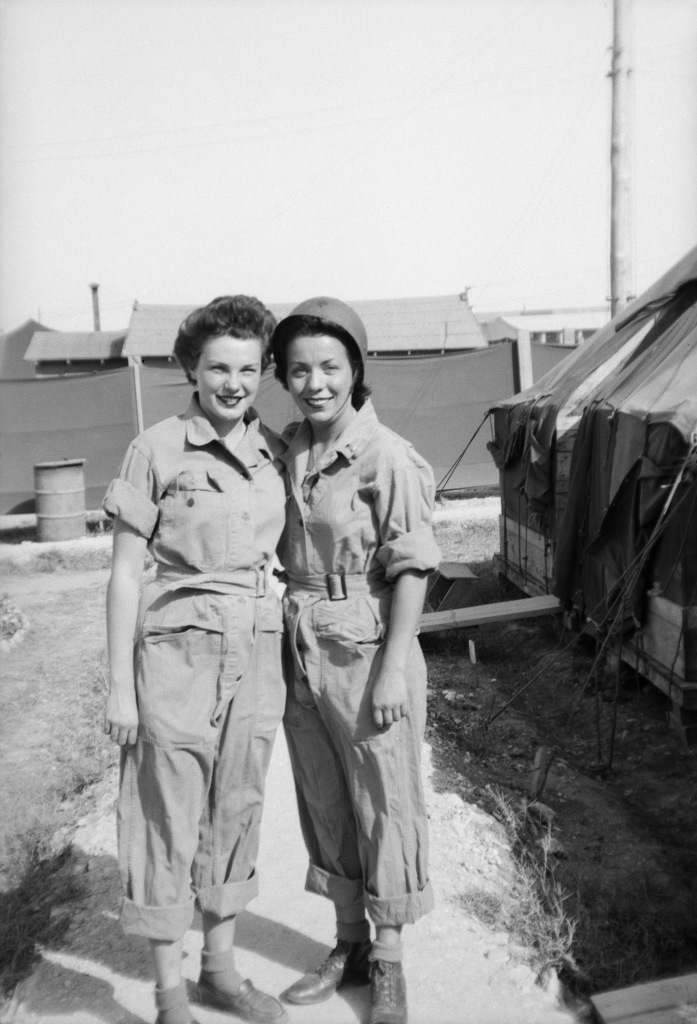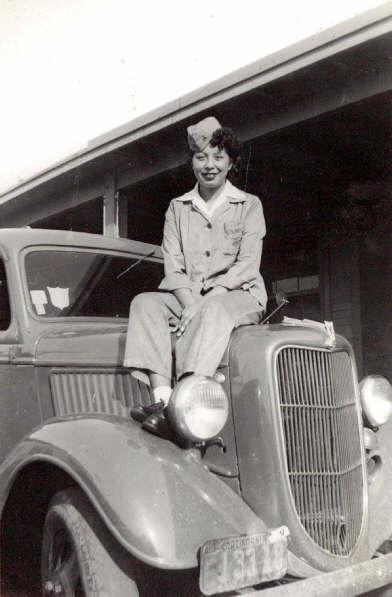
Women have worked for the American military in every major conflict, but until World War II they were largely classified as “civilians” and denied the benefits extended to men in uniform. The creation of the Women’s Auxiliary Army Corp (later renamed the Women’s Army Corp) in 1942 represented the first step toward official recognition of women’s military service. Other branches of the military quickly followed suit, and, like their national counterparts, Montana women took advantage of new opportunities to serve in the armed forces.
Mary Jo Hopwood, who was born in Colorado but eventually settled in Darby, Montana, served for three years in the Navy’s Women Accepted for Volunteer Emergency Service (WAVES). A combination of civic duty and desire for adventure motivated her to enlist: “[I]t was right after Pearl Harbor and everybody was patriotic,” she said. “[A]nd my brother was in the Navy, and I was just kinda restless. . . . It was adventure, mostly.” Although Hopwood worked in payroll, a common occupation for civilian women by the 1940s, she encountered doubts about her fitness to serve. “When we went in,” she recalled, “[the] commander said, ‘Well, I’m not used to having women around the office,’ but he said, ‘You have to take what they send you now days.’” Ultimately, that commander changed his mind, as did many other servicemen: “[T]hey didn’t think much of all these women,” Hopwood remembered. “But before we got out, they accepted us.”
While Hopwood worked in the relatively safe world of Navy payroll, other servicewomen performed more traditionally masculine jobs. Juanita Cooke served in the Army Air Force as a member of the Women’s Air Force Service Pilots (WASPS). Prior to the war, Cooke lived in California, where she worked as a cashier at a restaurant to earn money for flying lessons. She received her commercial pilot’s license just before she joined the Air Force in 1943. During her service, Cooke transported planes, and frequently her flights took her to the air base in Great Falls.
Montanan Minnie Spotted Wolf broke the barriers of both race and gender when she enlisted in the Marine Corps Women’s Reserve in July 1943. A member of the Blackfeet tribe, Spotted Wolf grew up on a ranch near Heart Butte. Her daughter later remembered Spotted Wolf as “real outdoorsy. . . . She was really good at breaking horses, and folks said she could outride guys into her early 50s.” Spotted Wolf’s ranch training served her well as a heavy-equipment operator for the Marines, and her unique background drew significant attention during the war. Headlines like “Minnie, Pride of the Marines, Is Bronc-Busting Indian Queen” dotted papers around the country.

Women who joined the armed forces had to prove that they could work in a masculine environment; they also had to demonstrate that they did not need special protection from their male coworkers. Historian Leisa Meyer argues that “a cultural inability to reconcile the categories of ‘woman’ and soldier’” led to “public fears of the consequences of establishing a women’s army.” In order to build acceptance for their newly formed female corps, the Army and Navy worked hard to safeguard the reputations of their female members. Mary Jo Hopwood recalled, “They thought we needed [to be] protected! . . . We were women, and they just figured you needed protecting from all the sailors that were around, so they put these restrictions on you.”
Hopwood believed that, like men’s skepticism about women’s ability to perform, this sense of paternalism faded over the course of the war: “[T]hey found that it wasn’t necessary, that we really could control ourselves and take care of our own destinies … but it was just really, it was new to them. It was a new thing.”
Although women gained the respect of their male comrades during their service, after the war their contributions were frequently downplayed. The lack of support for female soldiers disappointed Montana-born Grace Porter Miller, who served in the Women’s Army Corp: “These women who served their country well came home without honors or recognition. Women veterans have been shortchanged all the way.” Specifically, Miller pointed to the lack of medical care for World War II female veterans and the reluctance of male GIs to acknowledge female service members. For example, when Miller tried to join the Harlem, Montana, Veterans of Foreign Wars, she was told that she would have to join the ladies auxiliary instead. “But I was a bona fide veteran!” she protested.
While the formal inclusion of women in the armed forces during World War II represented a large step forward, conservative gender expectations still dominated Montana after the war. Clearly, society had not fully reconciled the categories of “woman” and “soldier.” Miller mused: “I have often tried to understand these responses. Perhaps men find it impossible to include women in their memories of the service: Girls aren’t supposed to fight; women aren’t supposed to be soldiers. Perhaps men think that acknowledgment that women served in the armed forces overseas during wartime would somehow detract from their own achievements as males. . . . [but] I have seldom argued. . . . I was too busy rebuilding my own life to bother about such things.” AH
Avon, Montana’s Doris Brander worked hard to make sure that women veterans received the recognition they deserved. Read about her in “Doris Brander and the Fight to Honor Women’s Military Service.
Sources
Cooke, Juanita. Interview by John Terreo, Helena, Montana, March 27, 1991, OH 1252, Twentieth Century Montana Military Veterans Oral History Project, Montana Historical Society Research Center, Helena.
_________. Interview by John Terreo, Helena, Montana, May 8, 1991, OH 1473, Twentieth Century Montana Military Veterans Oral History Project, Montana Historical Society Research Center, Helena.
Hopwood, Mary Jo. Interview by Diane Sands, Darby, Montana, September 4, 1987, OH 1035, Montana Historical Society Research Center, Helena.
Johnson, Peter. “Heart Butte Rancher Was First Native American Female in the U.S. Marines.” Montanicana: A Collection of Historical Articles about Montana and Its Culture. Available online at http://www.greatfallstribune.com/multimedia/Stories/spottedwolf.html. Accessed May 12, 2014.
“Memo to Pocahontas.” San Antonio Express, December 21, 1943.
Meyer, Leisa D. Creating GI Jane: Sexuality and Power in the Women’s Army Corps during World War II. New York: Columbia University Press, 1996.
Miller, Grace Porter. Call of Duty: A Montana Girl in World War II. Baton Rouge: Louisiana State University Press, 1999.
“Minnie, Pride of the Marines, Is Bronc-Busting Indian Queen.” Charleston Gazette, August 3, 1943.
White, Cody. “Minnie Spotted Wolf and the Marine Corps.” Prologue: Pieces of History, online at blogs.archives.gov/prologue/?p=12708. Accessed May 12, 2014.
One thought on ““You Have to Take What They Send You Now Days”: Montana Women’s Service in World War II”